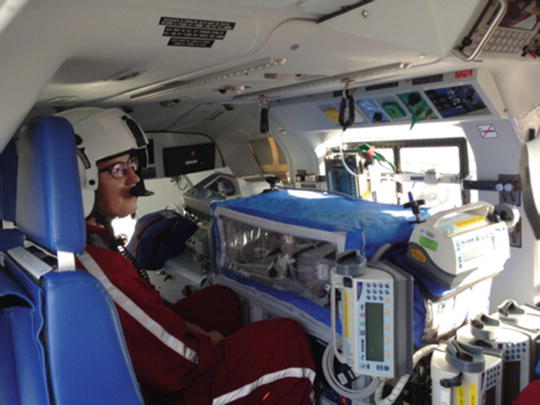Fig. 1
(a) The Children’s Hospital of Philadelphia Transport Team includes nurses, respiratory therapists, paramedics, EMTs, physician assistants, nurse practitioners, doctors, communications specialists, and other essential staff. (b) Members of the transport team participating in “Simulated Team Training” at the on-site helipad
Mode of Transport
The neonate with a critical airway is amongst the highest acuity patient. Consequently selection of the optimal transport mode—ground vs. air—is a crucial decision. In certain situations, critically ill neonates may be most appropriately transported by rotor-wing aircraft (helicopter). There are many variables which must be considered in this decision-making, and a well-designed, well-staffed “Transport Command Center” is often invaluable in these decisions.
Weather is often the initial determinant of whether air transport is feasible. Rain, snow, wind and fog may all preclude rotor-wing transport in most cases. It is important that the pilots of flight teams make their decision to fly without any knowledge of the degree of critical illness of the patient. This best practice prevents the acuity of the patient from compromising the safety of the crew—and patient.
Distance is also of obvious importance. Specific practice paradigms vary widely for “how far” or “how long” should prompt flight (versus ground) consideration, but many start considering flight near the 60 min ground transport time. Consequently, traffic patterns are also major factors. A premier Transport Command Center will have continual traffic pattern monitoring to aid in decision-making. The presence or absence of an on-site helicopter landing zone is also crucial. An on-site helipad is highly preferable (Fig. 2). If the helicopter must land remotely, the patient must be transferred to a ground ambulance at the remote site; this may negate some of the benefits of air transport.
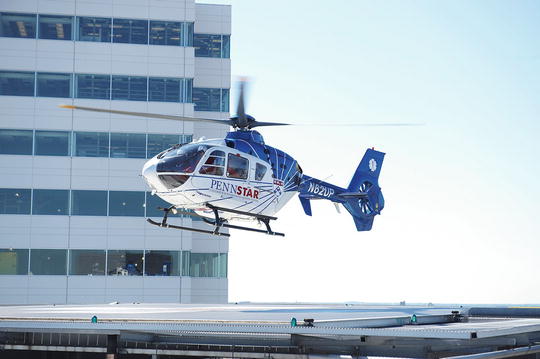

Fig. 2
Helicopter landing with a critical neonate at the on-site Children’s Hospital of Philadelphia transport helipad
Of course, the acuity of the patient factors heavily into the decision-making. It often seems intuitive that “flight is better” for the very sick babies because it allows for more rapid transport; however, in some cases, the opposite may be true. A small, cramped cockpit restricts access to the critical neonate, so some life-saving interventions (e.g. endotracheal intubation) may be more difficult. Monitoring is also more challenging, from auscultation of breath sounds to pulse oximetry measuring. Some of these factors are discussed in more detail below.
Other variables to consider include team or mode availability (e.g., aircraft wait times), ability of the aircraft to accommodate equipment (e.g., isolettes), weights of staff (fuel requirements are heavily contingent on both air temperature and weight of aircraft), and request of parents to travel with their transported baby. Sometimes, a hybrid transport method, such as sending team via ground ambulance, with planned return via helicopter, may be the quickest and safest option available.
There has been much media, professional, and government attention directed at the safety of medical helicopter transports in recent years, with some high-profile tragedies [12]. One report noted the use of rotor-wing transport may be more dangerous than other methods and should only be utilized when medically necessary [13]. While there is considerable disagreement over whether air transport is “more dangerous,” it is not controversial that each time flight is considered, the risks and benefits should be carefully considered (Table 1) and the safety of the crew, patient, and family should not be compromised if there are any concerns from any team member.
Table 1
Pros and cons of ground vs. helicopter vs. fixed-wing aircraft transports
Ground | Helicopter | Fixed wing | |
|---|---|---|---|
Advantages | Availability Convenience (only two transfers of patient required: hospital to ambulance and ambulance to hospital) Ideal environment for “mobile ICU” Relative cost | Rapid transit time | Rapid transit time over extremely long distances |
Ability to reach inaccessible or remote areas | Able to fly above or around inclement weather | ||
Cabin size larger than helicopter cabin | |||
Cabin pressurization | |||
Disadvantages | Not ideal for long distance transports | Adequate, unobstructed landing space required (field, helo pad, etc.) | Airport required |
Limitations of road and traffic conditions | Limitations of weather conditions (more prone to weather restrictions than ground transport) | Multiple transfers required (at least four transfers required: hospital to ambulance, ambulance to aircraft, aircraft to ambulance, ambulance to hospital) | |
Multiple transfers may be required | Long distance from airport to either referring or referral hospital | ||
Limited range because of fuel capacity (compared with both ground and fixed wing) | Noise and vibration interfere with monitoring the patient | ||
Limited cabin space | Environment stresses of altitude | ||
Lack of cabin pressurization | High maintenance cost | ||
Noise and vibration interfere with monitoring of patient | Expensive | ||
High maintenance costs | |||
Expensive | |||
Safety? |
Transfer of Responsibility
Regardless of how the team is to get there, after transfer acceptance, the referring facility must continue to manage the patient until the transport team arrives. The referring facility must keep the accepting facility updated on changes in the patient’s condition, as well as important diagnostic study results. The accepting facility continues to serve as a consultant, but again, the ultimate decision-making lies in the hands of the referring physician.
Upon arrival at the referring institution, transferring clinicians should provide further clinical updates. The transport team should be congenial and professional, and avoid any insinuations of suboptimal management. While collaborative management is always paramount, as long as the transport team is in the referring hospital, ultimate responsibility rests with the referring physician. The transporting team assumes full control of medical decision-making when they leave the referring facility.
Medical Records and Consents
The referring institution must copy all records and include copies of all radiologic images. For patients subject to EMTALA, it is a violation to send only radiologic reports and not actual copies of the radiologic studies. Again, it is logical that all patients be transferred with radiologic studies which can be reviewed by the receiving institution.
The referring facility must also obtain consent for transfer [14]. Medical necessity and risks must be explained to the parent or legal guardian. This requirement may be waived if an emergent transfer is necessary.
Part II. Transport of the Neonate with a Critical Airway
Initial Triage
The transport starts with initial triage of the patient, with active involvement from both the referring and accepting medical teams. As detailed above, a dedicated transport communication center is crucially important. All calls from outside hospital providers should be on recorded lines for quality assurance and improvement purposes, as well as for medical–legal considerations. It is most helpful for a member of the communications center staff to be actively listening to conversations between the referring and accepting physicians. This allows for “real-time” decision-making between the two clinicians and the transport team. It also allows for optimal coordination with groups not otherwise privy to these discussions, such as inpatient nursing leadership, bed management, and security. It also has the benefits of keeping the medical record up to date in a timely fashion. Finally, the transport team staff will often ask additional questions which may not be obvious to the medical command physician, but essential for transport. Some examples include questions about patient weight, the security of current intravenous access, the presence of copied radiographic studies and completion of consents, and parental availability at the referring hospital.
The medical command physician must, of course, ascertain the current adequacy of the airway and determine if recommendations are warranted for alternative airway procurement. A focused, pertinent history must be obtained to assess for prior difficulties with intubation or anatomic anomalies that might increase the likelihood of a critical airway. The respiratory status must be evaluated, along with the current mode of ventilation. Hemodynamic stability and support should be reviewed, as well as the current state of intravenous access. Teams must consider if there is specific time sensitivity for potential treatment protocol (i.e., therapeutic hypothermia) or surgical procedures (i.e., volvulus reduction.)
Pre-dispatch Preparation
After the decision has been made to transport a patient, preparations must be made to dispatch the team. Once the team composition and mode are determined (see above) the medical command physician and transport team clinicians must determine the equipment necessary for safe transport. This might include, for example, assuring that the isolette is compatible with the chosen mode of transport, and if inhaled nitric oxide is being used, ensuring its requisite set-up is appropriate (Fig. 3). Transport-ready “go-bags” (Fig. 4) stocked with a consistent set of common medications and standard equipment (Tables 2) are a must. In some cases, additional medications or equipment might need to be obtained prior to departure.
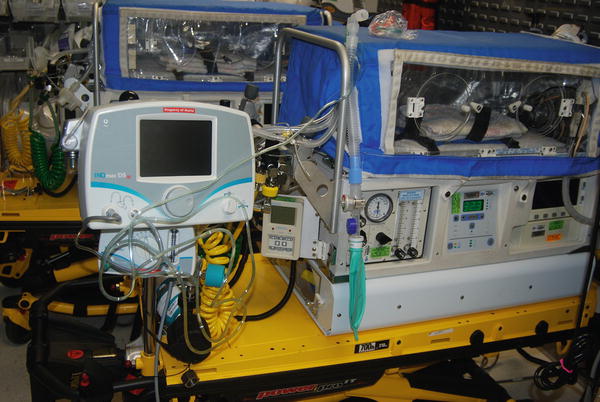
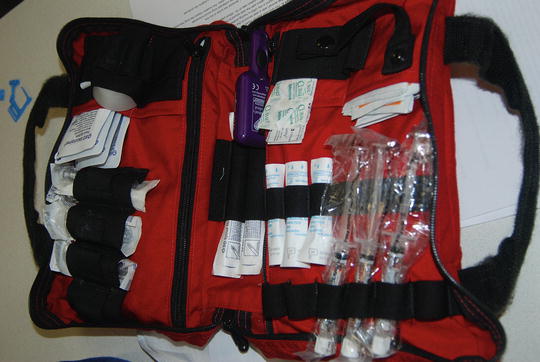

Fig. 3
Neonatal transport isolette with all standard equipment including a “built-in” neonatal ventilator, cardiopulmonary monitoring, inhaled nitric oxide all mounted on a sturdy sled

Fig. 4
Transport-ready “Go-bags” with all needed equipment and medications
Table 2
Basic equipment necessary for neonatal transport
Monitoring | Access | Point of care | Airway |
|---|---|---|---|
Mapleson bag | IV catheters | I-Stat Cartridges | Laryngoscopes |
Face masks | UV catheters | Capillary Tubes | Endotracheal tubes |
Nasal cannulas | IO supplies | Finger/Heel Lancets | Styletes |
Manometer with tubing | Tape | Glucometer | Magill forceps |
Flushes | Meconium aspirator | ||
Needles | Pedi-caps | ||
Syringes | Butterfly needles | ||
Electrodes | T-connectors | Ventilator set-up | |
Oximeter probe | Stopcocks | Inhaled nitric oxide set-up | |
End-tidal CO2 monitor | Alcohol/Betadine | ||
Arm boards | |||
Tegaderm dressing | |||
Gauze |
Table 3
Sedatives and paralytics commonly used for neonatal transport
Agent | Mechanism | Dose | Use | Onset | Recovery |
|---|---|---|---|---|---|
Ketamine | NMDA antagonist | 1–2 mg/kg IV | Dissociative agent | 1–2 mins | 5–10 mins |
3–4 mg/kg IM | |||||
Propofol | 2–4 mg/kg IV | Hypnotic, amnestic | 30–60 secs | 3–5 mins | |
Midazolam | GABA agonist | 0.05–0.1 mg/kg IV/IM | Sedation, anxiolysis | 3–5 mins | 20–30 mins |
0.2–0.3 mg/kg IN | 2–6 h (IM) | ||||
Lorazepam | GABA agonist | 0.05–0.1 mg/kg IV | Sedation, anxiolysis | 15–30 mins | Up to 8 h |
Pentobarbitol | GABA agonist | 2–3 mg/kg IV/IM | Sedation, anxiolysis | 3–5 mins | 15–45 mins |
Fentanyl | μ-opioid agonist | 1–2 μg/kg/ IV | Analgesia | 30–60 secs | 30–60 mins |
Morphine | μ-opioid agonist | 0.05–0.1 mg/kg IV | Analgesia | 20 mins | 3–5 hrs |
Atracurium | NDNMB | 0.25–0.4 mg/kg IV | Paralysis | 2–3 mins | 20–30 mins |
Cisatracurium | NDNMB | 0.1 mg/kg IV | Paralysis | 2–3 mins | 25–40 mins |
Rocuronium | NDNMB | 0.45–0.6 mg/kg IV | Paralysis | 60 secs | 25–35 mins |
Vecuronium | NDNMB | 0.1–0.2 mg/kg IV | Paralysis | 1–2 mins | 20–40 mins |
Pancuronium | NDNMB | 0.05–0.1 mg/kg IV | Paralysis | 2–3 mins | 45–120 mins |
The transport team must ensure that an adequate supply of oxygen is available for the duration of transport. This must factor in unexpected acute decompensations. The oxygen supply of each tank can be determined by the following formula:
Minutes of O2 flow = cylinder pressure x cylinder factor / flow of oxygen (in L/min).
Standard size tanks each have a coordinating cylinder factor: D (0.16), E (0.28), and H (3.14).
A pre-transport “Safety Checklist” is an invaluable tool for every transport team. This should be a comprehensive review of necessary equipment, medications, oxygen supply, essential demographic information, and other important reminders. All team members should participate in the completion of the safety checklist. This should be done for all modes of transport. A checklist should also be completed prior to departing for and from the referring institution. Fig. 5 depicts a sample checklist from The Children’s Hospital of Philadelphia.
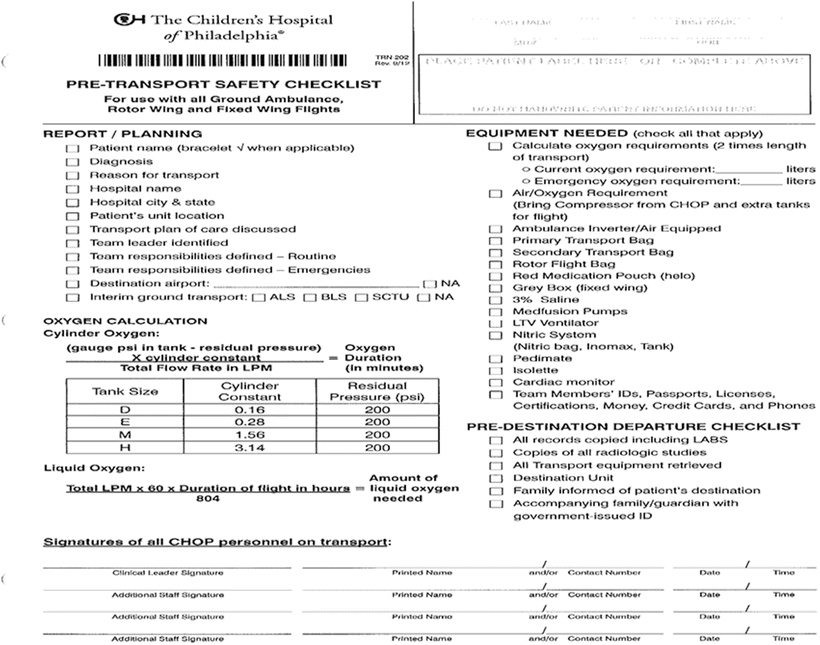

Fig. 5
Pre-Transport Safety Checklist used prior to departure
Considerations upon Arrival to Bedside
The arriving transport team should quickly perform an assessment to confirm clinical status. It is possible that the patient’s condition may have changed and be significantly different than anticipated. The transport team should establish continuous monitoring and confirm placement of all support tubes and lines. Care should be taken to minimize tangling of lines, which can increase risk of dislodgement. It is extremely important to have unobstructed intravenous access and to have all lines carefully labeled for fluid boluses, re-administration of sedation, or in case resuscitation medications become necessary.
Special attention should be made to the pre-transport stabilization of any advanced airway and widely used noninvasive airways such as nasal CPAP. Importantly, the use of nasal CPAP has risen substantially over the last ten years, with many more infants now being transported on these devices (Fig. 6).
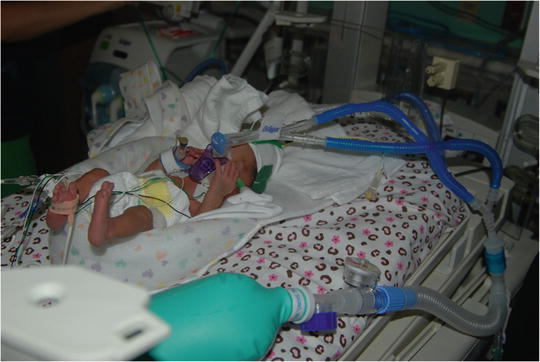

Fig. 6
Critical preterm neonate on nasal CPAP modified for transport
Before departing, recent radiographs should be reviewed to confirm endotracheal tube location and vascular access placement. A single-center study found that post-intubation chest radiographs resulted in endotracheal tube position change in nearly half of neonates awaiting transport. Not surprisingly, this was also associated with an increased time at referring hospital [15].
While all team members ideally should function in predetermined roles to streamline the process, it is also useful to have a team approach to ensure all duties at the outside hospital are completed in a timely fashion. Constant communication is paramount, and frequent reevaluations are necessary.
Consent
As above, the responsibility for obtaining consent for transport is primarily the role of the transferring institution. However, it is always good practice for the transport team to review the risks and benefits of the transport with the family. When practical, one team member may leave the immediate bedside to have this discussion with the parents. The needs for transport and additional resources available at accepting institution should have been reviewed with the family by the transferring physician, but these topics may be reinforced. Parents should have the opportunities to ask questions. Many institutions hand out a “Welcome Pamphlet” with important information about the receiving institution. When practical, support, such as clergy, should be present if requested.
Transfer of the Patient in an Isolette
The physical transfer of the patient to the isolette may be the point of greatest vulnerability to the patient. The team member executing the transfer is responsible for assuring lines and equipment do not tether patient. Astute attention must be paid to vital signs and patient response to transfer, with a team member free to respond quickly if intervention is required. The transfer process should be performed while attached to the referring hospital’s oxygen and medical air supply, thus reserving transport isolette resources for time out of hospital. Once the patient is in the transport isolette, a quick but thorough repeat assessment is performed of all support apparatuses before securing the patient into a neonate restraint system. After it is determined all necessary emergency equipment is accessible and belongings have been gathered, the last step is to disengage from referring hospital oxygen source, medical air, and electrical sources.

